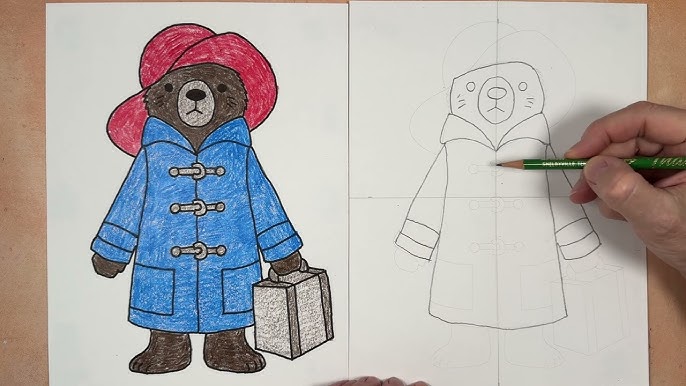Paddington drawing has become one of the most popular creative activities in the UK, loved by beginners, families, teachers and hobby artists alike. Paddington Bear remains a cultural treasure, and learning to sketch him offers a warm, nostalgic and confidence-building experience for anyone discovering art. Because his design is friendly, rounded and built from simple shapes, a Paddington drawing is an excellent starting point for people practising character illustration or looking for enjoyable easy drawing ideas.
A Paddington drawing also helps beginners understand structure, expression and proportion. His soft facial features and iconic clothing encourage artists to pay attention to detail without feeling overwhelmed. With a little patience and the right guidance, anyone can learn to draw Paddington at home, in school or as a relaxing pastime. This guide explores everything you need to know, from materials and step-by-step methods to creative ideas and skill-building tips, all designed to support new artists across the UK.
Materials You Will Need Before You Start
Before starting your Paddington drawing, gather a few essential tools to make the process smooth and enjoyable. A good-quality pencil, eraser and paper will be enough for most beginners. Sketching paper or a simple sketchbook works well, giving your pencil enough texture to create clean lines. Many UK artists enjoy starting lightly and building up shapes gradually, which is ideal for perfecting Paddington’s gentle expression and rounded features.
For those interested in adding colour, coloured pencils, markers or soft pastels will enhance your Paddington drawing beautifully. Digital artists may choose to work on a drawing tablet, especially if they enjoy experimenting with layers, textures and easy adjustments. No matter your tools, the goal is comfort and creativity. These same materials support various art styles such as flower drawing, butterfly drawing, easy drawing ideas, animal sketches or even detailed eye drawing.
Understanding Paddington’s Key Features
Creating a charming Paddington drawing is easier when you understand his defining features. Paddington Bear is instantly recognisable thanks to his bright red hat, blue duffle coat and friendly smile. His proportions are soft and rounded, making him approachable for new artists. Observing these details helps you stay true to his classic design while still allowing room for your personal style to shine through.
Another helpful tip is to break Paddington into simple shapes. His head can begin as a circle, his body as an oval, and his limbs as gently curved lines. This shape-based method is ideal for beginners and builds confidence for more complex projects later on, such as dog drawing, cat drawing, elephant drawing or dragon drawing. Once you can capture Paddington’s essence using basic forms, you will find character illustration much more accessible.
Step-by-Step Paddington Drawing Tutorial for Beginners
Beginning your Paddington drawing starts with sketching the underlying structure. Lightly draw a circle for the head and an oval for the body, keeping everything soft and balanced. Add guidelines to position the eyes, nose and smile. This foundation helps you understand proportions and ensures your final drawing remains consistent. The goal at this stage is simplicity and accuracy rather than detail.
Next, focus on adding Paddington’s expressive features. Draw two gentle eyes, a small rounded nose and a warm smile. These elements give your Paddington drawing its personality. After the face, move on to the iconic red hat, using slightly curved lines to show the soft fabric. Then sketch the blue duffle coat, adding the toggle buttons and loose folds. Finally, draw the arms, paws and boots, keeping shapes rounded and beginner-friendly. When your sketch is complete, outline it neatly, erase guidelines and begin colouring.
Paddington Drawing Ideas for Creative Inspiration
There are endless possibilities when it comes to personalising your Paddington drawing. Some artists enjoy a classic look, while others experiment with different artistic styles such as cartoon, realistic, chibi or minimalist designs. You can place Paddington in seasonal scenes like Christmas, drawing him with a Christmas tree or wrapped in a cosy scarf. These festive themes pair wonderfully with other Christmas drawing projects and make delightful gifts or decorations.
If you prefer nature-inspired artwork, you can draw Paddington in a garden full of flowers, combining your skills with flower drawing, rose drawing or tree drawing. For fun storytelling illustrations, add animals such as a cat, dog, elephant or fish. Creative artists sometimes enjoy blending Paddington with fantasy themes, pairing him with a friendly dragon or including elements from spooky skull drawing styles. These imaginative variations make the learning process exciting and open new pathways for artistic growth.
Skill-Building Tips for Beginner Artists
Improving your Paddington drawing skills comes with regular practice and an open mind. Start by sketching simple shapes daily and experiment with line strength, shading and proportions. Practising a variety of subjects such as butterfly drawing, eye drawing or easy drawing ideas helps you gradually expand your artistic confidence. The more you draw, the easier it becomes to understand angles, curves and character expressions.
Reference images are extremely helpful, offering guidance on posture, clothing and facial structure. Digital artists can benefit from layers and undo tools when using a drawing tablet. Traditional artists may enjoy drawing games that build creativity and loosen stiff lines. These exercises support stronger artistic instincts, making your future Paddington drawings even more impressive.
Extra Drawing Tutorials Related to Paddington
Paddington drawing naturally connects to other beginner-friendly drawing subjects. Many artists enjoy exploring related themes such as flowers drawing, dragon drawing, christmas tree drawing, dog drawing or cat drawing. These subjects help strengthen your observational skills and improve your understanding of shapes, shading and texture. Practising a variety of topics ensures a more balanced and confident artistic journey.
Animal drawings such as elephant drawing and fish drawing also share fundamental shapes that beginners can easily master. These complementary skills make character art more enjoyable and less intimidating, allowing you to grow gradually while maintaining your creativity and enthusiasm.
Conclusion
Learning Paddington drawing is a heartwarming and rewarding experience for beginners and seasoned artists alike. With simple shapes, expressive features and endless creative possibilities, Paddington is a perfect subject for building artistic confidence. Whether you prefer traditional pencils or a digital drawing tablet, sketching Paddington opens the door to a fulfilling and imaginative art journey. Keep practising, explore new drawing ideas and enjoy every moment of your creative development.
Frequently Asked Questions
What makes Paddington drawing suitable for beginners?
Paddington uses simple shapes and soft details, making him easy for new artists to draw.
Do I need expensive materials?
No, basic pencils and paper are enough for a wonderful Paddington drawing.
Can children follow this guide?
Yes, the steps are simple and child-friendly, perfect for creative family activities.
How long does a Paddington drawing take?
Most beginners complete it in 20 to 40 minutes, depending on detail.
What other drawings help build skill?
Practising flower drawing, butterfly drawing, dog drawing or eye drawing supports steady improvement.
You may also read: Themes and Motifs in The Echo of Old Books


